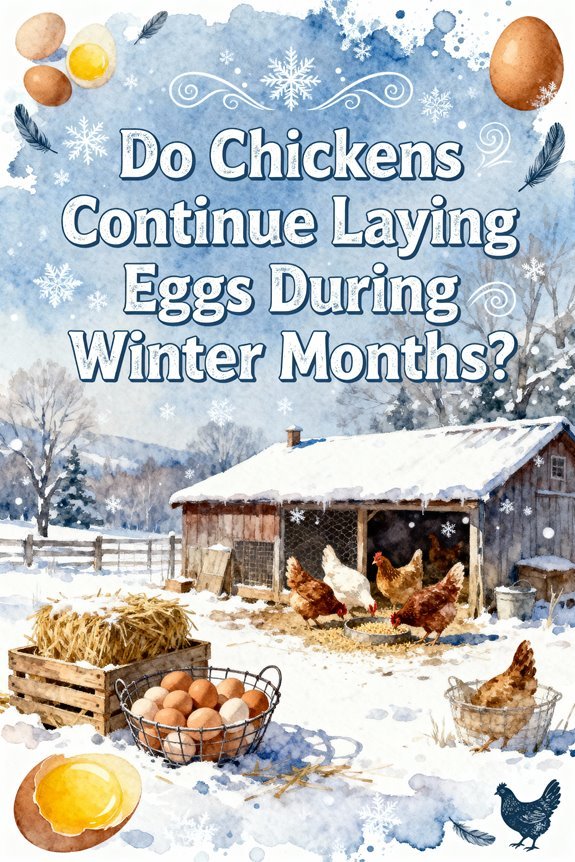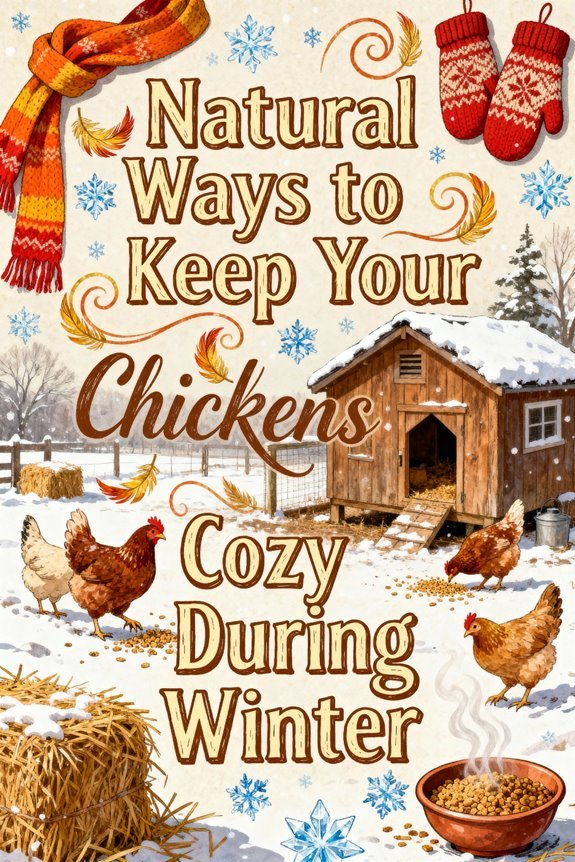Do Chickens Continue Laying Eggs During Winter Months?
Your chickens will naturally reduce or stop egg laying during winter as daylight hours shorten and temperatures drop. They need 14-16 hours of light daily for consistent production, and winter’s shorter days trigger their bodies to conserve energy. While some breeds handle cold better than others, you can maintain egg production by providing supplemental lighting, proper nutrition, and winter-ready housing. Understanding these key factors will help you keep collecting eggs through the cold months.
Understanding Natural Egg Production Cycles
When it comes to egg production, a hen’s natural laying cycle follows a predictable pattern governed by daylight hours and hormones. Your chickens’ pineal gland interprets light exposure, triggering reproductive hormones that control their egg-laying schedule. This internal clock typically operates on a 24-26 hour cycle. Most hens require 12-14 hours of daylight to maintain consistent egg production throughout the year.
You’ll notice peak egg production during longer spring and summer days, when increased daylight stimulates hormone secretion and frequent ovulation. As days shorten in fall, your hens’ bodies naturally begin producing fewer eggs. Regular mite prevention helps maintain optimal laying conditions during seasonal transitions. By winter, most hens noticeably reduce or stop laying altogether as their bodies conserve energy for survival. This seasonal slowdown isn’t a health issue – it’s your chickens’ natural response to shorter days and colder weather, allowing them to rest and preserve resources until spring returns. Young hens in their first two years typically maintain the most consistent egg production through seasonal changes.
The Impact of Seasonal Light Changes
Light plays an essential role in your chickens’ egg-laying abilities, with hens requiring at least 14 hours of daily light exposure to maintain consistent production. As winter approaches and natural light decreases, your hens’ pineal glands respond by increasing melatonin production, which naturally suppresses egg laying. Installing LED light fixtures can provide reliable and energy-efficient supplemental lighting for your coop.
When daylight drops below 12 hours, you’ll notice a significant decline in egg production as your hens’ hormonal cycles adjust to the seasonal change. This response varies by breed and age, with older hens typically being more sensitive to reduced light. While cold-hardy breeds might fare better, all chickens experience some production decrease without supplemental lighting. You can counteract this by installing incandescent bulbs in your coop, timed to extend daylight hours and maintain your flock’s laying schedule throughout winter. Using lights in the red to orange spectrum can most effectively stimulate your hens’ reproductive systems. For optimal health, ensure your chickens still get adequate dark hours each night to maintain their natural rest cycle and immune function.
Managing Winter Laying Success
Understanding light’s role in egg production sets the foundation for successful winter management strategies. You’ll need to provide 14-16 hours of consistent light using timers and properly positioned bulbs to maintain laying patterns. Install lights about seven feet high with reflectors for even distribution. Hardy breeds like Rhode Island Reds adapt better to winter conditions.
Water management becomes critical during cold months – you’ll need heated bases or regular thawing to guarantee constant access to fresh water. For ideal feed efficiency, keep feeders full and offer scratch grains in the evening for extra warmth. Ensure laying hens receive balanced nutrition rather than broiler feed to meet their specific needs. Don’t forget to provide appropriate-sized grit for proper digestion. Chickens require 2 pounds of water for every pound of feed consumed.
Collect eggs twice daily to prevent freezing and cracking. You’ll also want to maintain 4-6 inches of dry bedding and guarantee proper ventilation without drafts to keep your hens comfortable and productive throughout winter.
Breed Selection for Cold Weather Performance
Selecting cold-hardy chicken breeds forms the cornerstone of successful winter egg production. When you’re choosing your flock, focus on breeds with characteristics specifically suited for cold climates. Look for chickens with small combs and wattles, like Brahmas and Cochins, as they’re less susceptible to frostbite. While Old English Game birds are robust, they require special consideration due to their active and spirited nature.
Consider breeds known for their dense feathering and consistent egg laying abilities. Buff Orpingtons, Rhode Island Reds, and Golden Laced Wyandottes have proven track records as cold hardy breeds that maintain egg production through winter months. You’ll find that these breeds combine practical features like heavy feathering with reliable laying patterns. While heritage breeds like Langshans naturally handle cold well, modern hybrids can offer both cold tolerance and improved egg production, giving you the best of both worlds. Providing your hens with proper accommodations will help maintain consistent egg laying throughout the coldest months.
Nutritional Requirements During Winter Months
After establishing your cold-hardy flock, proper winter nutrition becomes the next pillar of consistent egg production. Your hens need increased protein sources during these cold months to maintain warmth, support feather regrowth, and sustain egg laying. Aim for feeds containing 14-17% crude protein. Natural supplements like dried black soldier flies can provide an excellent protein boost. Adding crushed oyster shells will help ensure strong eggshell formation throughout winter.
Winter nutrients must include balanced carbohydrates for energy, but don’t overdo scratch grains. You’ll notice your chickens eating up to 25% more as they work to stay warm. Proper water access is absolutely critical, as chickens can only survive 12-48 hours without it. Keep fresh water available at all times, using heated waterers if necessary to prevent freezing. Supplement with essential vitamins and minerals through complete feeds, and don’t forget grit for proper digestion. While treats can encourage activity, they shouldn’t replace balanced nutrition. Remember, a well-fed hen at roosting time is better equipped to handle cold nights.
Creating an Optimal Winter Environment
When temperatures plummet, your chickens’ coop becomes their primary sanctuary, making proper winter housing essential for continued egg production. You’ll need to provide at least 4 square feet per bird and guarantee ideal insulation to maintain stable temperatures without compromising coop ventilation. Install protected windows that allow airflow while preventing drafts, and position 2-inch-wide roosting bars for comfortable night rest. Consider implementing the deep litter method during winter months to provide natural insulation and warmth.
Your winter chicken coop should include one nest box for every 3-5 hens. Focus on predator prevention by reinforcing your coop with durable, weather-resistant materials, as winter often increases predator activity. Don’t forget winter enrichment – provide dust baths, foraging toys, and interactive activities to keep your flock engaged during confinement. Use gentle restraint techniques when administering any winter health treatments to ensure proper care. Clear snow from entrances regularly, and make sure your roof can handle snow loads. Remember, a well-designed winter environment greatly affects your hens’ laying consistency.
Supplemental Lighting Strategies
Light plays an essential role in maintaining your hens’ egg production through winter’s darker days. You’ll need to provide 14-16 hours of total light daily to maximize laying rates. Install LED or compact fluorescent bulbs near the coop’s ceiling for even light distribution, as these bulb types offer safe, efficient illumination throughout the year. Natural daylight in northern regions drops to under nine hours by December. Hens normally lay one egg daily as part of their natural reproductive cycle. While these backyard birds can reach flight heights of 8-10 feet, they generally stay close to their coops when properly housed and fed.
Set up timers to extend morning or evening light gradually, adding about 15 minutes weekly until you reach the target duration. A single 60-watt equivalent bulb works well for most backyard coops. Keep the light spectrum consistent and clean your fixtures weekly to maintain peak output. With proper lighting, you can sustain up to 80% laying rates year-round, though winter production may still dip to 60-70% in hybrid hens.
Common Winter Production Challenges
During winter months, your chickens face multiple challenges that can considerably impact egg production. Cold temperatures force your hens to divert energy from laying to staying warm, especially when coops drop below 55°F. Your flock may increase feed consumption to compensate, but they’ll still lay fewer eggs. Consider providing extra nesting materials to maintain comfort and encourage consistent laying. Offering scratch grains before bedtime helps chickens generate warmth through digestion overnight.
Watch for signs of molting, which typically occurs in late fall and can halt laying for up to 16 weeks. You’ll need to boost protein intake during this time to support feather regrowth. Keep an eye on water accessibility, as frozen water leads to dehydration and reduced laying. Installing raised platforms with straw can help protect chickens from cold ground exposure. Stress from overcrowding can trigger feather pecking and further decrease production. Additionally, cold drafts and poor insulation create environmental stress that disrupts your hens’ laying patterns.
Health Considerations in Cold Weather
As temperatures drop, your hens’ bodies undergo significant physiological changes that require careful health monitoring. Watch for behavioral signs of cold stress, including huddling, holding one foot up, or excessive feather puffing. These indicators suggest your birds are struggling to maintain body heat. Providing a nesting box size appropriate for your breed helps ensure comfortable shelter during winter months.
Your hens’ nutritional needs will increase substantially during winter, as they burn more energy staying warm. They’ll need high-quality feed rich in protein, especially methionine, to prevent feather pecking and support healthy molting. A complete layer feed formula with 16-20% protein helps maintain winter egg production. Keep water sources unfrozen and accessible, as proper hydration is essential for digestion and overall health.
Remember that healthy hens handle cold better than those weakened by disease or parasites. If coop temperatures fall below 35°F, consider adding supplemental heat to prevent stress and maintain your flock’s well-being. Cold hardy breeds typically demonstrate better resilience during harsh winter conditions.
Maximizing Winter Egg Collection
Maintaining healthy hens sets the foundation for strong winter egg production, but you’ll need specific strategies to keep your layers productive through the cold months. The key is providing 14-16 hours of consistent light exposure daily, as natural winter daylight isn’t sufficient to sustain laying. Install timers to extend morning light hours, mimicking natural patterns. Using warm wavelength bulbs will better stimulate your hens’ reproductive system.
Keep your coop’s temperature between 55-65°F to stabilize egg production and adjust feed accordingly. Your hens will need more calories to offset cold stress, plus extra protein and calcium to support egg laying. Choosing nutrient-rich feeds from quality brands helps ensure optimal winter nutrition. Don’t forget fresh, unfrozen water daily. Easter Egger chickens are particularly hardy birds that adapt well to winter conditions. During molting periods, which naturally occur in winter, boost nutritional support to help your flock return to laying sooner. Remember that sudden changes in light or temperature can disrupt laying patterns, so maintain stable conditions throughout winter.




